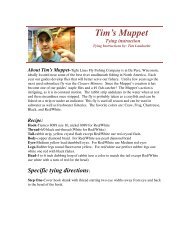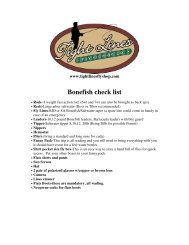30-41 Achigan - Tight Lines Fly Fishing Co.
30-41 Achigan - Tight Lines Fly Fishing Co.
30-41 Achigan - Tight Lines Fly Fishing Co.
You also want an ePaper? Increase the reach of your titles
YUMPU automatically turns print PDFs into web optimized ePapers that Google loves.
<strong>30</strong>-<strong>41</strong> <strong>Achigan</strong> 6/19/06 7:32 PM Page 34<br />
included restoring streams and lakes to<br />
bring back the “good old fishing days.”<br />
Sid Gordon, author of How to Fish from<br />
Top to Bottom (1955), for a time headed<br />
the program to improve aquatic habitat.<br />
Fish hatcheries were important to<br />
this rehabilitation effort. The first fish<br />
hatchery in the country was built in<br />
Madison about 1875. A bass hatchery<br />
was established in 1903 in Minocqua,<br />
and by 1940, Wisconsin had eight stateoperated<br />
bass hatcheries that produced<br />
between 1.5 and 2.5 million fry and fingerlings<br />
per year.<br />
In the 1950s it was clear that natural<br />
reproduction was sufficient to maintain<br />
bass populations and stocking was<br />
almost eliminated. Even so, much of<br />
the bass stocking that took place in the<br />
early 20th century<br />
was for largemouths,<br />
which<br />
were stocked mostly<br />
in lakes.<br />
Stocking of smallmouths<br />
was<br />
minor, and limited<br />
bass stocking has<br />
returned in recent years.<br />
The struggles of Wisconsin’s aquatic<br />
resources didn’t end in the ‘40s and<br />
‘50s, however. Senator Gaylord Nelson<br />
founded Earth Day in 1970—the impetus<br />
for the establishment of the<br />
Environmental Protection Agency and<br />
the Clean Water Act.<br />
It was finally some help to address<br />
years of abuse of water resources.<br />
Dams remain a complex issue.<br />
Hydropower is a relatively clean energy<br />
source, but the negative impacts are<br />
obvious, such as restricting fish passage<br />
for spawning and dramatic flow changes<br />
that flood or strand fish. New laws<br />
make it easier for the Wisconsin<br />
Department of Natural Resources and<br />
groups such as the Wisconsin River<br />
Alliance to have a voice in protecting<br />
rivers when hydroelectric dams come<br />
up for relicensing.<br />
So, Where are We Now<br />
Many Wisconsin rivers are better<br />
today than they were several decades<br />
and even 100 years ago. Most rivers<br />
designated by the DNR as Outstanding<br />
& Exceptional Waters are in the northwoods.<br />
The return of smallmouth bass to<br />
northern Wisconsin is especially<br />
BAR TEAU M I N N E A U X<br />
PATTERN BY BART LANDWEHR<br />
TIED BY BART LANDWEHR<br />
HOOK: Tiemco 8089NP, size 6<br />
THREAD: White 6/0 Uni-thread<br />
TAIL: Gray Icelandic sheep fur over pearl<br />
Flashabou over silver Flashabou over<br />
white bucktail<br />
LATERAL LINE:<br />
Two peacock herl each side<br />
THROAT: Red rabbit<br />
COLLAR: White Ice Fur<br />
UNDERBODY:<br />
White medium chenille<br />
BODY/HEAD:<br />
Pearl blue Angel Hair spun in dubbing<br />
brush; top colored with cool<br />
gray Pantone pen<br />
EYES: Silver or pearl 3-D molded, size 5.0<br />
NOTE: Vary the pattern by coloring with different<br />
pens. The Barteau is a great saltwater pattern<br />
as well and has been used to catch<br />
many species including jacks, stripers and<br />
snook; substitute a stainless hook.<br />
BASS S A N D W I C H<br />
PATTERN BY BOB MARVIN AND<br />
NELSON HAM<br />
TIED BY NELSON HAM<br />
HOOK: Daiichi 2461, size 1/0<br />
THREAD: Chartreuse 6/0 Uni-thread, Flatwaxed<br />
Nylon for attaching foam<br />
TAIL: Two chartreuse marabou plumes<br />
LEGS: Orange round rubber hackle<br />
UNDERBODY:<br />
Chartreuse Estaz<br />
BODY: White 6mm craft foam, front cut at<br />
45-degree angle<br />
EYES: 7mm doll eyes<br />
NOTE: Body is from The Happy Face <strong>Fly</strong> by<br />
Captain Bob Marvin, Naples, Florida. It’s<br />
a simple but effective way of creating a popper<br />
from sheet foam. Substitute rabbit strips,<br />
craft fur, bucktail, or feathers for the tail.<br />
Rubber legs can be attached to front foam<br />
tie-in. Fish with short, quick strips and give<br />
good pops. A long strip will pull the fly<br />
underwater, resulting in a big air bubble and pop.<br />
impressive if you consider that the<br />
species received little help after the logging<br />
era and the modern population is<br />
self-supporting. Stocking numbers from<br />
the Wisconsin DNR are telling: In fiscal<br />
year 2005, about 14,000 smallmouths<br />
were stocked statewide—compared to<br />
about 170,000 largemouths and over 20<br />
million walleye, three million pike and<br />
two million brown trout.<br />
The smallmouths seem to be doing<br />
well on their own, but this doesn’t mean<br />
they aren’t susceptible to over harvest.<br />
A trophy fishery can be lost in a hurry.<br />
<strong>Co</strong>nvincing more anglers to practice<br />
catch-and-release and to not fish for<br />
bass protecting their nests during the<br />
spawn is critical.<br />
Why<br />
First, there isn’t much scientific<br />
debate that removing a male from a<br />
nest, even for a few minutes, results in<br />
some mortality to eggs or fry. And there<br />
is no question that a guardian removed<br />
permanently from a nest results in complete<br />
mortality. Basically, fishing to a<br />
bass on a nest is a bit like hunting deer<br />
chained to a fencepost—let them be.<br />
Second, there is a common misconception<br />
that bass numbers are near<br />
those of trout in similar-quality streams.<br />
As John Lyons, fisheries biologist for the<br />
Wisconsin DNR, told me, “…because<br />
bass are higher up on the food chain<br />
[largely fish and crayfish eaters versus<br />
aquatic insects]…more total primary<br />
and secondary productivity is needed to<br />
produce a pound of bass than a pound<br />
of trout.”<br />
He went on to explain that anglers<br />
and even some fishery managers have<br />
unrealistic expectations as to how many<br />
bass a stream can support. Lyons’ years<br />
of research suggests that trout will have<br />
maximum densities three to 10 times<br />
higher than bass, all other things being<br />
equal.<br />
Finally, bass in colder, less-productive,<br />
northern waters grow much slower<br />
than those in southern states. A 20-<br />
inch river bass from northern<br />
Wisconsin is easily 10 years old or more.<br />
Catch-and-release angling is vital to<br />
supporting and improving the fishery.<br />
Their river homes and lives are tough,<br />
even without the destruction of days<br />
gone by. The smallmouths still endure<br />
the dams, ice, cold, heat, floods, pike,<br />
musky and countless other obstacles.<br />
A trophy smallmouth is more than<br />
anything a survivor, “one who struggles.”<br />
Waiting for Popper Time<br />
When I met my clients that July<br />
morning last year, we dropped my driftboat<br />
at a launch below a dam, and I ran<br />
my shuttle. My two smallmouth mentors,<br />
Tim and Bart Landwehr from<br />
<strong>Tight</strong> <strong>Lines</strong> <strong>Fly</strong> <strong>Fishing</strong> near Green Bay,<br />
had found their “shuttle girl” a couple<br />
of years earlier. Still in high school, she<br />
drove fast enough—seemingly powered<br />
by bubble gum and pink flipflops—and<br />
I was back at the ramp in 15 minutes.<br />
As I rowed away from shore, I knew<br />
we would quickly be out of the dam’s<br />
sight and then float seven miles without<br />
hearing a car and only seeing a cabin or<br />
two. My anglers started casting minnow<br />
patterns at bank eddies, and within five<br />
minutes both had 14-inch smallmouth.<br />
We started into a long straight reach.<br />
Here the river flows over those 2-billion-year-old<br />
rocks and also follows a<br />
fault—a suture zone where ancient<br />
North America added a new piece of<br />
crust a long time ago.<br />
I barely had to move the oars to drift<br />
just so. Otherwise I stared at the water,<br />
alternating between my angler’s flies<br />
and the bank far ahead, looking for the<br />
telltale swirl of a surface take. No swirls<br />
yet, but it was only midday.<br />
We stuck with my mid-summer play<br />
and kept on fishing big streamers, but I<br />
was so wishing for popper time.<br />
Summer Strategies, or, Keeping it Slow<br />
I’m no different than most bass<br />
anglers who believe catching smallmouths<br />
on the surface is simply the<br />
best. There is good fishing in Wisconsin<br />
spring and fall, but a hot July and<br />
August are the halcyon days of northwoods<br />
smallmouth fishing.<br />
<strong>Fishing</strong> smallmouths in a big<br />
Wisconsin river can seem daunting, but<br />
keep two things in mind:<br />
First, there is a lot of unproductive<br />
water.<br />
Second, you aren’t going to find many<br />
spots where you’ll catch 20, 10 or even<br />
five fish too often. So, besides recognizing<br />
good structure, it’s best to cover<br />
large amounts of water.<br />
One strategy that I use mid-summer<br />
involves searching with a large (four-tosix-inch)<br />
streamer on a floating line<br />
(e.g. Murdich Minnow). Fish such<br />
Fish large salt water flies with short, erratic strips to imitate dying minnows. Then,<br />
annoy the heck out of your driftboat companions by catching all of their fish.<br />
TIBOR REEL AD<br />
34 F ISH& F LY<br />
S UMMER 2006 35




